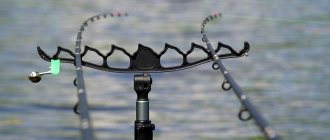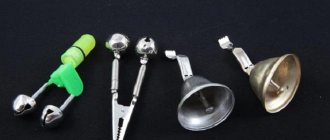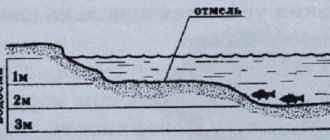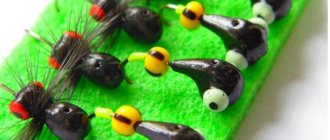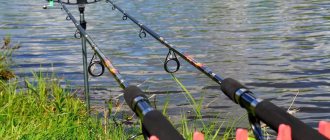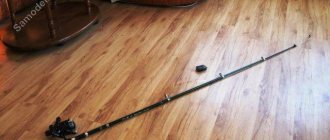Bell in feeder rig
Controlling fish bites through a sensitive feeder tip in amateur fishing not only does not exclude, but also presupposes the use of such a time-tested sound bite alarm as a bell.
A recent incident prompted me to touch on this seemingly simple topic. A friend who came to visit found me in the process of replacing the factory plastic bell clamps with homemade ones. Surprised by what he saw, he asked why I, who was seriously interested in feeder fishing, needed such an anachronism. So it turned out that many people have no idea how the bell fits into the concept of modern bottom fishing.
Since this is the case, I will try to explain that modern approaches in amateur fishing are by no means replacing bells; they can be used even when fishing with a feeder. Everything is simple here. This is not sport fishing, where there is a fight for every second, for every fish, and it is impossible to be distracted. There is an opportunity to fish for pleasure, in comfort, without haste. Of course, control over bites is carried out exclusively by a sensitive quiver tip, but many situations arise when additional installation of bells will allow you not to miss a bite and even save the rod. As a result, the bells act as a backup sound alarm, which has a secondary, but also important role. They complement the visual bite indicator (feeder tip) and, in tandem with it, make fishing more pragmatic.
I'm talking about cases when you need to leave the workplace and, say, take a short break to eat. Or collect brushwood for a fire in the forest, or go get something from a car parked at a distance from the water’s edge. And if we talk about night feeder fishing, then with bells, when a lack of bite occurs, it becomes possible to calmly close your eyes and take a nap for half an hour or an hour, sitting in a chair near the rod. In general, there can be many situations, and they arise on absolutely every fishing trip. Therefore, you should be guided by an unwritten rule: leave the feeder under the supervision of bells for a short time, and remove the equipment from the water for a long time in order to avoid undesirable consequences.
If this is not done, irreparable things can happen to an abandoned feeder left on slingshots. And this is not only the loss of a trophy due to a bite that happened unnoticed. A fish or a branch floating with the current can simply drag the tackle along with it. This has happened to me more than once, and only thanks to the ringing bells I was able to fly up to the shore and grab the rod. In addition, when fixing the feeder on a strong stand, the same tripod, a situation is possible when a hooked fish breaks the rod. And it’s good if the tip breaks, but what if it’s a different knee? In general, you either need to guard the feeder from the beginning to the end of fishing, or insure yourself with bells that will ring if they ring in case of any movement.
I don’t consider the bell as a possible alternative to bells, because it has a different purpose. This is a pure bite alarm, attached to a fishing line, and adding it to the feeder is simply pointless. No compatibility.
Donka for crucian carp: how to make it yourself
The design of the gear is simple: the equipment consists of a rod (you can do without it), main fishing line, weight, leashes and hooks. It is easier to wind the vein onto the reel by attaching a lead weight to the end using a blind or sliding method. The number of leashes depends on the preferences of the fisherman, but there is no point in knitting more than five pieces. Hooks must match the size of the bait.
Using a rod and reel allows you to cast bait over a long distance, and large crucian carp prefer to live away from the coastal zone. In reservoirs with a clean bottom, you can send the tackle to the required place and aim it with your hand, choosing the correct weight of the sinker. When fishing with this equipment, worms, maggots, corn, potatoes, and dough are used as bait. Having installed a small live bait, you can hope to catch pike, pike perch, and perch, but it is worth remembering that the tackle is “tailored” for peaceful fish.
To learn more:
Electronic bite alarm Barracuda
Voiced tuning
The structure of a bell is the simplest. It is a hollow metal ball with a slot on one side and a hole on the opposite side. A piece of freely moving metal rod is placed inside it. The ball is screwed into the indicated hole with a spring and is connected to a clip-clothespin. The latter is mounted on a slingshot stand or fishing rod. When biting, vibration occurs and the bell makes a ringing sound.
Having indicated the possibility of attaching a bell to a slingshot stand or a fishing rod, I will make a reservation. You should only choose the first option. Clicking the alarm on the feeder form is a bad practice. With this option, after each bite you will have to spend time removing the bell from the rod, risking losing the trophy. You can, of course, fish with a bell, but then the risk of catching a fishing line or braided cord on its spring increases at the most inopportune moment, which will lead to tangling of the equipment and a similar negative result.
In addition, the most popular bell on a plastic clothespin, when working methodically with a feeder, can also fly into the water, since its clamp is not so tight, and besides, the further such clamps are produced, the shorter some manufacturers make the gripping “cheeks” with teeth. I was convinced of this when comparing clamps of the same design, one of which was released twenty years ago, and the second today.
Plus, the ringing from the shaking of the bell due to the rod moving during fishing is heard so much that it can drive both the donker and his neighbors crazy, simultaneously scaring away the fish. Then you will have to listen to it again the next time you cast the equipment, and so on throughout the fishing with short intervals of calm. And if you fasten a bell to the feeder tip, this can also negatively affect its sensitivity.
Unfortunately, one regularly hears such polyphony on reservoirs, because obvious things do not reach people. It would seem that there is nothing simpler than attaching it to a slingshot stand and catching, but many people don’t realize it. As a result, they themselves suffer, irritate and irritate their neighbors. But let's move on.
To ensure your bell works effectively, you should do the following before you start fishing. Do not firmly fix the slingshot stand in the ground. It should wobble slightly in order to increase the vibration necessary for the bell to ring when biting. In this case, the bell is attached either to a support rod or on “horns”.
I don’t see any problems when using a tripod for feeder fishing. In order for the bell to ring well even on it, I simply slightly unscrew the clamping screw of the V-shaped rod holder or “comb” to which I attach the alarm. And even though with this option the structure moves only back and forth, this is already enough to enhance the sound effect of the bell when biting.
Feeder alarms
In feeder fishing, many different bite alarms have been invented. These are a variety of pendulums, rattles, swingers, side nods, electronic signaling devices and, of course, bells or bells. Most often, all these solutions are used for targeted fishing for carp or carp, when the gear is installed for a long time. At the same time, the fisherman is engaged in some other business on the shore, and reacts to the activation of a sound or light detector. Read more in the article about feeder alarms.
This kind of fishing is highly specialized and more similar to carp fishing. For ordinary amateurs, all these bells and whistles are not needed, but sometimes an alarm is required, especially when bites are not frequent. In this case, the principle “the simpler the better” works. The main inconvenience of all these gadgets is installation problems. Additional structures appear on the gear, making it more difficult to work with. If this is justified in the waiting tactics, then in active fishing problems may arise - overlaps, entanglements, loss of time for installation. The vast majority of anglers use simple bells. If you need it, you put it in, if not, you take it away and you catch it using the quivertip. Let's look at how to place the bell on the feeder correctly so that it does not interfere with active work with the tackle.
Industrial bells
Modern industry produces many different bells, trying to keep up with the times to meet the growing needs of anglers. The main differences between them are observed in the types of fasteners used, the number and size of bells (the last two characteristics are not so significant).
The first type of fastener is represented by plastic clips or alligator clips with one or two bells. They just appeal to me. The operating principle is based on compression of spring clamps. Such bells can be installed on flyer stands under fishing rods and on the fishing rods themselves, but this has already been discussed above.
The alligator clip appears to be much more reliable in terms of fastening, but it has an additional disadvantage. Sharp teeth invariably damage everything they touch and therefore you have to hide them under tensioned cambrics.
The second type of fastener is represented by bells on plastic latches. Most often, you just need to press with your finger, and the fastener will appear on the rod blank. To minimize fishing line snags, the manufacturer even added a kind of protective casing to the fasteners.
There is also a more complex version of the specified clamp, when, after installing it on the form, the fixation is carried out by twisting the plastic cap. Rotating along the thread, it simultaneously pulls a special casing onto the fastener. As a result, a blind connection of the bell is made. It will never fly off the form until you perform the reverse manipulations with unwinding. The disadvantages of both alarms are associated with snags in the fishing line (braided cord) and the constant inevitable ringing when casting and retrieving the equipment.
Well, in concluding the subsection, I will point out the positive “twist” that is found on all of the above varieties of bells, with the exception of the “crocodile”. This is a hole for luminous capsules (light stick), intended for night fishing. True, the disadvantages listed above cast doubt on the need to resort to this option. Unraveling or tying a rig at night is twice as difficult as during the day. So it is much more convenient when the bell is fixed on a stand, and the top of the feeder is illuminated at night by a lantern or a similar “firefly”, but on a separate mount without a bell.
Personal “life hack” with bells for the feeder
I don’t like the word life hack, but forgive me, I already wrote it and wrote it.
So here it is. Many of us use feeder bells. What are the main disadvantages - the constant ringing when playing - it hurts the ears not only of yourself, but also of your neighbors. The opportunity to be surrounded by other feeders - if the bite is not very good, then the bells give us away.
They often fly anywhere, and unfortunately, including into the water. At certain moments, they can tangle the fishing line and prevent it from passing through the rings of the stick.
What do I do when I fish with bells?
My feeder stands parallel to the ground on two flyers.
So, I tie a fishing line to the flyer, on which part of the feeder with the tip rests.
I tie the other end of the fishing line to a bell. When I put the feeder down after casting, I clamp the top ring of the tip with a bell. When biting and hooking, due to the fact that the bell is tied with a fishing line to a peg, it simply falls to the ground, and I don’t have to look for it, it doesn’t irritate with the ringing.
No duplicates found
Life hack: you need to catch fish on the feeder, and not drink or fuck with your neighbors. And it’s better to keep the bells warm.
I agree, bells on the feeder bad manners))) if you really need to step away or get distracted, open the baitrunner and that’s it or get exhausted
I hang a bell on the rod, when the feeder is removed from the rod it stops ringing
I do the same. It’s so infuriating that people don’t know this method, which I think is correct.
I know about the spear, but I will never use this method. There will be no reaction to a weak bite. What is the point then of putting thin tips and hanging a bell on the very tip? The purpose of the feeder is to see or hear the bite. You can also hang a bell on an oak tree. If a catfish bites, it may ring.
Have you heard of this? Even a weak bite will cause a reaction.
Also, all the bells have the same key))) and if there are 50 people on the pond.
The bell hack is to not be an asshole and leave it at home. The bludgeoners with the bells really got it.
Sure thing!! Oil painting. We arrive at the water, unpack, get in the way, sitting next to us are blue muzzles with crocs, ten of them per mug, blue under the grill, they look at us like, well, well.. we have a heavy vehicle + nishtyaks. After 3 hours they sucked with the catch
Those who say that they are sick of those who hang bells are sick of them.
If you fish “purely in a spartive way,” then bells are not needed at all. You really have to plow there - re-cast in 3-5 minutes. And you have to constantly stare at the top. And for relaxation, bells are really nothing. He sat down, took a gram of cognac during the first cast - babble.
Facepalm.jpg Why the hell do you need a feeder? The whole point of this fishing method is to keep at the point a minimal small food spot from a lump that is not capable of saturating the fish, quickly being washed out of the feeder and at the same time attracting it with the aroma and a small portion of the large fraction and living component. You cast, you snatch, there’s not a damn thing left at the point, but you still need to snatch the second one with a minimum break, then fuck for your life, smoke a cigarette, snatch a third, and then maybe it will come to the second cast. Donkey Crocodile, bells, spring feeder and porridge as big as a baby's head: The choice of blue professionals.
What "So what?"? Why the hell is it a feeder? Buy about 5 crocodiles for the price of an average feeder and have some left over for nipping.
Do not confuse a feeder rod + feeder tackle and any stick with a bell; these are two stsuko definitely different methods of fishing. I shake the feeders’ paw five times, and greet the crocodiles with bells. I’m racing Mikado ultraviolet 120 in heat and only on quiver, which is what I wish for everyone, everything else is collective farm.
Photos are not enough for clarity
With an active bite, you will get tired of getting up and hooking the bell every time.
with active biting it is not needed. Stand and watch the tip.
I burned the remains of the feeder and sold it for copper, what a life hack. It's a pity that we have now switched to optics.
Well, not everyone is such a craftsman) someone will be interested and use this method.
And I place the fishing rod parallel to the shore and before hooking I remove the bell
I also came to ask what is stopping you from removing the bell?
Do you have a feeder five centimeters long? How do you manage to run to the top when biting, remove the bell, run back and hook? Or do they only bite monsters, and swallow them right up to the gills so that they won’t come off?
Two 2.7 and one 3.6, it seems, on short ones I shoot freely without running anywhere, on long ones I take an extra step forward. Do you have feeders ten meters long, what do you need to “run”?
“Many of us use feeder bells.”
“What do I do when I catch bells?”
“I tie the other end of the fishing line to a bell.”
“I clamp the top ring of the top with a bell”
You fishermen are so vulgar!
In what way? What's so vulgar? Are you all right? Doesn't a bottle of water remind you of a penis, or does a bathroom remind you of an open vagina?
Author's version
I was prompted to upgrade the bells indicated at the beginning of the material by the fact that only one of the old stocks with plastic clips remained, and the new ones turned out to be unreliable due to their shortness.
When deciding on the issue of strengthening the fit of fasteners for bells, I tried different options. In the end, I couldn’t find anything better than replacing the plastic clothespin clips with metal clothespins that were once used to attach window curtains. Their advantage is a reinforced spring and a tenacious grip with interlocking teeth.
The entire process of upgrading one bell took no more than ten minutes. I started work by removing the springs with bells from the plastic fasteners. Since they had become deformed over time, I straightened them. To do this, I simply strung them on an awl and slightly squeezed them with pliers. The springs have taken on their lost original form.
Next, I cut out two parts in the form of washers with protrusions-legs from the polymer jar lid. Their size was determined based on the diameter of the upper parts of the clothespin, which are pressed with your fingers. The polymer jar lid is thick, is not afraid of transformation, can be cut effortlessly with a sharp knife and does not even require further sanding of the parts.
I put springs on the protrusions-legs of the washers, after which I attached both parts to the factory clothespin using miniature bolts and nuts. If desired, they can be replaced with rivets, including polymer ones from the same lid, followed by melting.
The final touch of the work was the formation of the correct shape of the clip-clothespin, which will allow it to sit more tightly on the cylindrical stand of the flyer stand. To do this, I used round pliers to bend each of the two metal “cheeks” of the clothespin, giving them the required shape. It also allows you to attach the bell to the comb without damaging it with the sharp teeth of the clothespin. The sensible bell is ready.
Source
Video text
Subscribe to the salapinru channel - https://goo.gl/0RYxP5 Our online store: https://sonik-shop.ru
Feeder bells are hollow metal balls, inside of which solid small metal balls are freely placed, which create a characteristic sound when moving. The bells themselves are mounted on a spring suspension, which ensures their sensitivity. There is also a mounting device.
It is best to choose bells with fasteners such as a clip or a clothespin. It is the most convenient to use. There are screw-on options, but they are not suitable for us; we will not install this device on the top of the feeder.
A freshly purchased bell needs to be modified immediately

